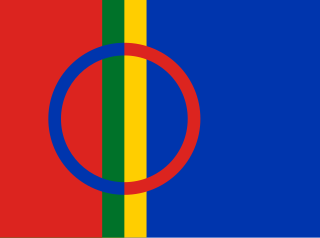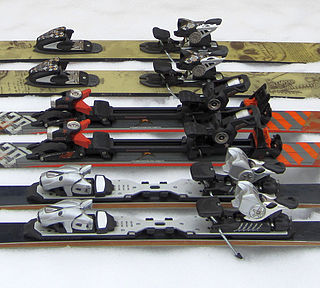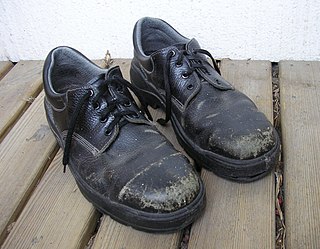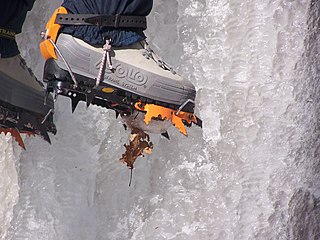
The Sámi are the traditionally Sámi-speaking Indigenous peoples inhabiting the region of Sápmi, which today encompasses large northern parts of Norway, Sweden, Finland, and of the Kola Peninsula in Russia. The region of Sápmi was formerly known as Lapland, and the Sámi have historically been known in English as Lapps or Laplanders, but these terms are regarded as offensive by the Sámi, who prefer their own endonym, e.g. Northern Sámi Sápmi. Their traditional languages are the Sámi languages, which are classified as a branch of the Uralic language family.

A shoe is an item of footwear intended to protect and comfort the human foot. Though the human foot can adapt to varied terrains and climate conditions, it is vulnerable, and shoes provide protection. Form was originally tied to function, but over time, shoes also became fashion items. Some shoes are worn as safety equipment, such as steel-toe boots, which are required footwear at industrial worksites.

Footwear refers to garments worn on the feet, which typically serve the purpose of protection against adversities of the environment such as wear from rough ground; stability on slippery ground; and temperature.

Snowshoes are specialized outdoor gear for walking over snow. Their large footprint spreads the user's weight out and allows them to travel largely on top of rather than through snow. Adjustable bindings attach them to appropriate winter footwear.

Skiing, or traveling over snow on skis, has a history of at least eight millennia. The earliest archaeological examples of skis were found in Karelia and date to 6000 BCE. Although skiing's origins were purely utilitarian, the modern sport evolved from beginnings in Scandinavia, starting in the mid-1800s skiing became a popular recreational activity and sport, becoming practiced in snow-covered regions worldwide, and providing a market for the development of ski resorts and their related communities.

A boot is a type of footwear. Most boots mainly cover the foot and the ankle, while some also cover some part of the lower calf. Some boots extend up the leg, sometimes as far as the knee or even the hip. Most boots have a heel that is clearly distinguishable from the rest of the sole, even if the two are made of one piece. Traditionally made of leather or rubber, modern boots are made from a variety of materials.

A ski binding is a device that connects a ski boot to the ski. Before the 1933 invention of ski lifts, skiers went uphill and down and cross-country on the same gear. As ski lifts became more prevalent, skis—and their bindings—became increasingly specialized, differentiated between alpine (downhill) and Nordic styles of skiing. Until the point of divergence in the mid-20th century, bindings held the toe of a flexible, leather boot against the ski and allowed the heel to rise off the ski, typically with a form of strap or cable around the heel.

Tabi are traditional Japanese socks worn with thonged footwear such as zori, dating back to the 15th century.

A steel-toe boot is a durable boot or shoe that has a protective reinforcement in the toe which protects the foot from falling objects or compression. Safety shoes are effective in keeping the feet of industrial workers safe from sharp and heavy objects while working in factories.

A crampon is a traction device attached to footwear to improve mobility on snow and ice during ice climbing. Besides ice climbing, crampons are also used for secure travel on snow and ice, such as crossing glaciers, snowfields and icefields, ascending snow slopes, and scaling ice-covered rock.

Sandals are an open type of shoe, consisting of a sole held to the wearer's foot by straps going over the instep and around the ankle. Sandals can also have a heel. While the distinction between sandals and other types of footwear can sometimes be blurry, the common understanding is that a sandal leaves all or most of the foot exposed. People may choose to wear sandals for several reasons, among them comfort in warm weather, economy, and as a fashion choice. Usually, people wear sandals in warmer climates or during warmer parts of the year in order to keep their feet cool and dry. The risk of developing athlete's foot is lower than with enclosed shoes, and the wearing of sandals may be part of the treatment regimen for such an infection.

Winklepickers or winkle pickers are a style of shoe or boot worn from the 1950s onward, especially popular with British rock and roll fans such as teddy boys. The feature that gives both the boot and shoe their name is the very sharp and long pointed toe, reminiscent of medieval footwear and approximately the same as the long pointed toes on some women's high-fashion shoes and boots in the 2000s. They are still popular in the goth, raggare and rockabilly subcultures.

Opanci are traditional peasant shoes worn in Southeastern Europe. The attributes of the opanci are a construction of leather, lack of laces, durable, and various endings on toes. In Serbia, the design of the horn-like ending on toes indicates the region of origin, though this specific design is not exclusive to Serbia. The opanci are also considered as the traditional peasant footwear for people in the Balkan region. In Bulgaria they are referred to as "tsarvuli".

Mukluks or kamik are soft boots, traditionally made of reindeer (caribou) skin or sealskin, and worn by Indigenous Arctic peoples, including Inuit, Iñupiat, and Yup'ik.

Engineer boots, also known as engineer's boots or engineering boots, are an American type of traditional leather work-boots. Their lace-less, rugged construction made them popular among motorcycle riders. Originally developed in the 1930s for firemen working on steam locomotives, the boots gained substantial popularity in the post–World War II era during a growing motorcycling culture. They became popular symbols of teenage rebellion in the 1950s and a common component of greaser wear. They were later adopted by skinheads and punks in the 1970s. By the 2010s, engineer boots were being popularly worn for fashion purposes, especially by non-traditional customers such as women, young urban professionals, and hipsters.

A court shoe or pump is a shoe with a low-cut front, or vamp, with either a shoe buckle or a black bow as ostensible fastening. Deriving from the 17th- and 18th-century dress shoes with shoe buckles, the vamped pump shape emerged in the late 18th century. By the turn of the 19th century, shoe buckles were increasingly replaced by black bows, which has remained the contemporary style for men's formal wear, leather or patent leather evening pumps ever since. This latter style is sometimes also called an opera pump or opera slipper.

Yup'ik clothing refers to the traditional Eskimo-style clothing worn by the Yupik people of southwestern Alaska.

Sámi clothing is clothing used by the Sámi. The style of clothing they use varies among regions and language groups, but there are many common or similar elements. Traditional elements are often included in modern Sámi clothing to signify Sámi identity.

Traditional Inuit clothing is a complex system of cold-weather garments historically made from animal hide and fur, worn by Inuit, a group of culturally related Indigenous peoples inhabiting the Arctic areas of Canada, Greenland, and the United States. The basic outfit consisted of a parka, pants, mittens, inner footwear, and outer boots. The most common sources of hide were caribou, seals, and seabirds, although other animals were used when available. The production of warm, durable clothing was an essential survival skill which was passed down from women to girls, and which could take years to master. Preparation of clothing was an intensive, weeks-long process that occurred on a yearly cycle following established hunting seasons. The creation and use of skin clothing was strongly intertwined with Inuit religious beliefs.




















